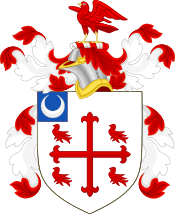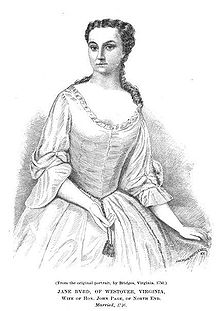William Byrd II
His enterprises included promoting Swiss settlement in mountainous southwest Virginia and iron mining ventures in Germanna and Fredericksburg.
The following year he was elected as a Fellow in the Royal Society with the support of Sir Robert Southwell, his father's friend.
[1] By this time, Byrd spent much of his childhood in England, but born in Virginia, where he was expected to return, he was not accepted as an Englishman.
Due to his education and his father's influence, he was elected to the House of Burgesses in the fall of that year, but he withdrew in October to return to London, where he practiced law.
In 1702, he attempted to have Nicholson removed from office, but the petition was rejected by the Crown and Byrd lost his position on the council.
[1] Lieutenant Governor Alexander Spotswood reorganized the collection of quitrents in order to enlarge the royal revenue.
Byrd felt that he was responsible for the operations of the receiver's office and had objected to Spotwood's actions and saw it as a personal affront.
Both were passed by the Virginia General Assembly, but it received a royal veto, which Byrd considered a personal win.
In 1728, he was appointed to survey the Virginia and North Carolina border by the next Lieutenant Governor Sir William Gooch.
[1] The Tobacco Inspection Act of 1730 was passed and Byrd's land was chosen for construction of a warehouse, of direct benefit to him.
[1][4] Lucy lived near Colonial Williamsburg at the Parke's Queen's Creek plantation in York County, Virginia with her mother and her sister Frances.
Her father, who lived with his mistress, forbade the women from entertaining male callers and did not provide the money for them to have clothes of their station.
Byrd notes in his diary entry for July 15, 1710 that Parke, "against my will caused little Jenny to be burned with a hot iron, for which I quarreled with her".
[8] Based on his diary, Byrd was singularly focused on treating his wife as a subordinate and did not foment closeness with their children.
She received the news without the least fright, and was persuaded she would live… Gracious God what pains did she take to make a voyage hither to seek a grave.
She was certainly well-mannered, and epitomised the upper-class lady that he desired, without any record of passionate "flourishes" to quell arguments or threatening the servants.
It was originally written in a shorthand code and deals mostly with the day-to-day aspects of Byrd's life, many of the entries containing the same formulaic phrases.
I had good health but wicked thoughts, God forgive me.In addition to the passages recounting his many infidelities, the diary also contains a record of the lives of slaves held by Byrd and his subsequent punishment.
Byrd often beat the slaves he held and sometimes devised other punishments even more cruel and unusual: September 3, 1709: I ate roast chicken for dinner.
He collected books written in English, French, Italian, Dutch, Hebrew, Greek, and Latin on a wide range of subjects.
Considered one of the greatest colonial libraries, he had 3,500 volumes, including biography, history, architecture, science, divinity and law.
[14] The History of the Dividing Line is Byrd's most influential piece of literary work and is now featured regularly in textbooks of American Colonial literature.
According to Pierre Marambaud, Byrd "had first prepared a narrative, The Secret History of the Line, which under fictitious names described the persons of the surveying expedition and the incidents that had befallen them.
His major works include: William Byrd II died on August 26, 1744, and was buried at Westover Plantation in Charles City County.




